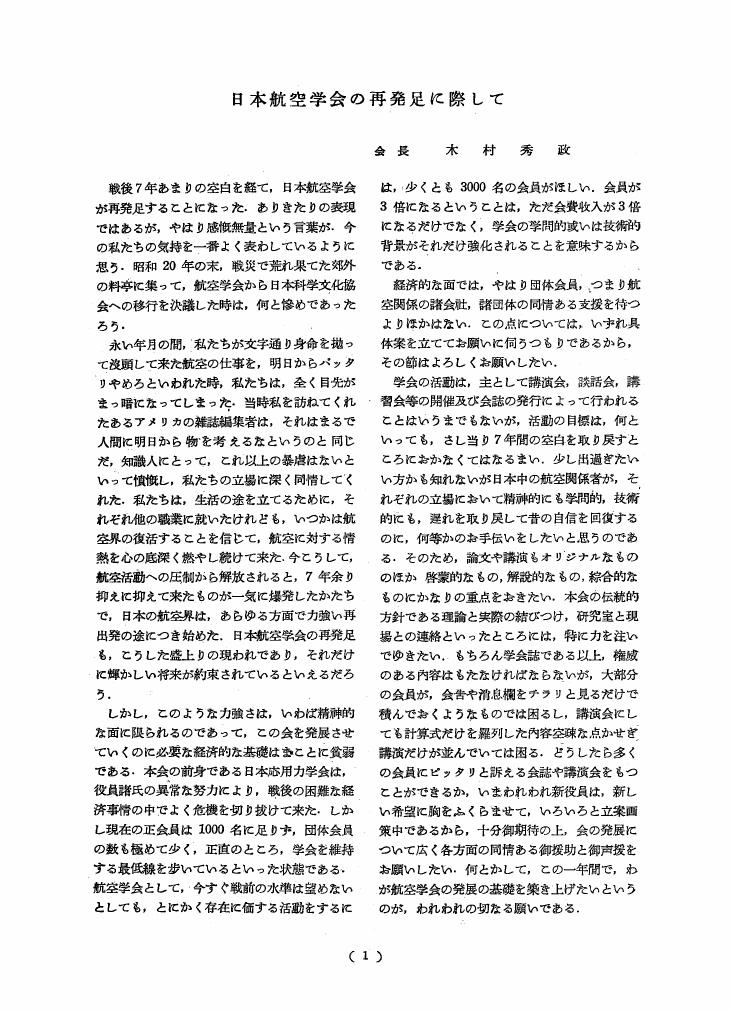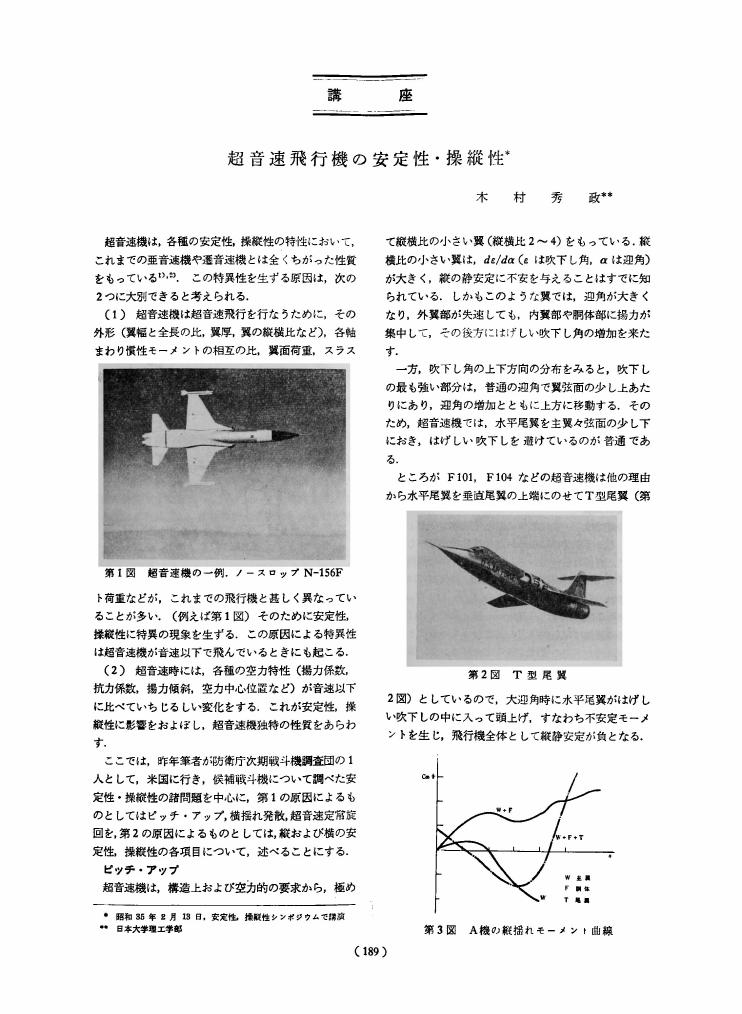14 0 0 0 OA 無尾翼機の縱の動安定について : 無尾翼機の研究 第2報
- 著者
- 木村 秀政
- 出版者
- 宇宙航空研究開発機構
- 雑誌
- 東京帝國大學航空研究所彙報
- 巻号頁・発行日
- vol.209, pp.13-24, 1942-01
13 0 0 0 OA 無尾翼飛行機の縱の靜安定について
- 著者
- 木村 秀政
- 出版者
- 宇宙航空研究開発機構
- 雑誌
- 東京帝國大學航空研究所彙報
- 巻号頁・発行日
- vol.204, pp.307-318, 1941-08
13 0 0 0 OA 記録,統計,時報
- 著者
- 木村 秀政 高坂 憲三
- 出版者
- 一般社団法人 日本航空宇宙学会
- 雑誌
- 日本航空學會誌 (ISSN:18835422)
- 巻号頁・発行日
- vol.6, no.51, pp.812-819, 1939-07-05 (Released:2009-07-09)
5 0 0 0 OA 日本航空学会の再発足に際して
- 著者
- 木村 秀政
- 出版者
- 一般社団法人 日本航空宇宙学会
- 雑誌
- 日本航空学会誌 (ISSN:00214663)
- 巻号頁・発行日
- vol.1, no.1, pp.1-1, 1953-06-30 (Released:2009-07-09)
4 0 0 0 OA 遷音速機の設計について(座談会)
4 0 0 0 OA 人力飛行機
- 著者
- 木村 秀政 内藤 晃
- 出版者
- 一般社団法人 日本航空宇宙学会
- 雑誌
- 日本航空宇宙学会誌 (ISSN:00214663)
- 巻号頁・発行日
- vol.32, no.360, pp.15-22, 1984-01-05 (Released:2009-05-25)
- 参考文献数
- 10
4 0 0 0 OA 過去半世紀における飛行機設計の進歩
- 著者
- 木村 秀政
- 出版者
- 一般社団法人 日本航空宇宙学会
- 雑誌
- 日本航空学会誌 (ISSN:00214663)
- 巻号頁・発行日
- vol.2, no.6, pp.122-135, 1954-03-31 (Released:2009-07-09)
- 参考文献数
- 14
2 0 0 0 IR 無尾翼機の昇降舵の効きについて : 無尾翼機の研究第3報
- 著者
- 木村 秀政
- 出版者
- 東京帝國大學航空研究所
- 雑誌
- 東京帝國大學航空研究所彙報
- 巻号頁・発行日
- no.244, pp.443-457, 1944-12
資料番号: SA4415923000
1 0 0 0 OA ブレゲーBr. 940“アンテグラル”STOL輸送機
- 著者
- 木村 秀政
- 出版者
- 一般社団法人 日本航空宇宙学会
- 雑誌
- 日本航空学会誌 (ISSN:00214663)
- 巻号頁・発行日
- vol.6, no.58, pp.333-334, 1958-11-28 (Released:2009-07-09)
1 0 0 0 ヴィッカース・ヴァンガード輸送機
- 著者
- 木村 秀政
- 出版者
- 一般社団法人 日本航空宇宙学会
- 雑誌
- 日本航空学会誌 (ISSN:00214663)
- 巻号頁・発行日
- vol.7, no.63, pp.119-120, 1959
1 0 0 0 OA シコルスキーHSS-2対潜哨戒ヘリコプタ
- 著者
- 木村 秀政
- 出版者
- 一般社団法人 日本航空宇宙学会
- 雑誌
- 日本航空学会誌 (ISSN:00214663)
- 巻号頁・発行日
- vol.7, no.65, pp.173-174, 1959-06-28 (Released:2009-07-09)
1 0 0 0 遷音速機の設計について(座談会)
1 0 0 0 人力飛行機
- 著者
- 木村 秀政 内藤 晃
- 出版者
- 一般社団法人 日本航空宇宙学会
- 雑誌
- 日本航空宇宙学会誌 (ISSN:00214663)
- 巻号頁・発行日
- vol.32, no.360, pp.15-22, 1984
1 0 0 0 人力飛行機STORK B
- 著者
- 木村 秀政
- 出版者
- 社団法人 日本流体力学会
- 雑誌
- nagare (ISSN:02867540)
- 巻号頁・発行日
- vol.10, no.2, pp.1-2, 1978
1 0 0 0 OA 人力飛行機STORK B
- 著者
- 木村 秀政
- 出版者
- 社団法人 日本流体力学会
- 雑誌
- nagare (ISSN:02867540)
- 巻号頁・発行日
- vol.10, no.2, pp.1-2, 1978 (Released:2011-03-07)
1 0 0 0 OA 超音速飛行機の安定性・操縦性
- 著者
- 木村 秀政
- 出版者
- 一般社団法人 日本航空宇宙学会
- 雑誌
- 日本航空学会誌 (ISSN:00214663)
- 巻号頁・発行日
- vol.8, no.78, pp.189-194, 1960 (Released:2009-07-09)
- 参考文献数
- 5
1 0 0 0 OA 初級グライダーの地上衝撃測定結果
- 著者
- 木村 秀政 落合 一夫 塚田 進章
- 出版者
- 一般社団法人 日本航空宇宙学会
- 雑誌
- 日本航空学会誌 (ISSN:00214663)
- 巻号頁・発行日
- vol.5, no.45, pp.295-298, 1957 (Released:2009-07-09)
- 参考文献数
- 1
1 0 0 0 OA 垂直尾翼容積と螺旋不安定度
- 著者
- 木村 秀政
- 出版者
- 一般社団法人 日本航空宇宙学会
- 雑誌
- 日本航空學會誌 (ISSN:18835422)
- 巻号頁・発行日
- vol.9, no.81, pp.32-45, 1942-01-05 (Released:2009-07-09)
- 参考文献数
- 10
1 0 0 0 OA 飛行機の重量区分について
- 著者
- 木村 秀政
- 出版者
- 一般社団法人 日本航空宇宙学会
- 雑誌
- 日本航空学会誌 (ISSN:00214663)
- 巻号頁・発行日
- vol.2, no.7, pp.167-170, 1954-07-31 (Released:2009-07-09)
- 参考文献数
- 2
1 0 0 0 飛行機の離陸性能測定結果の修正及び其の應用
- 著者
- 木村 秀政
- 出版者
- 宇宙航空研究開発機構
- 雑誌
- 東京帝國大學航空研究所報告
- 巻号頁・発行日
- vol.13, no.169, pp.453-471, 1938-09
In this report, some problems concerning the corrections to the measured results of take off run of an aeroplane are discussed. All the examples of test results referred to are those on the Koken long-range monoplane on a concrete runway. The take off run of an aeroplane depends to a large extent on how the aeroplane is piloted at the moment of leaving the ground, that is to say, at what speed the aeroplane takes off. Since the personal difference of the pilotage is unavoidable, the results of take off tests on an aeroplane, though corrected to the no wind and standard atmospheric conditions, are very scattered, as shown, for example, in Fig. 10, where measured take off runs are plotted against weight. In order to use the test results for the purpose of the estimation of take off run at the overloaded condition, or for the comparison of take off characteristics between different propellers, the effect of the personal difference must be eliminated. The method of reduction is simple and practical as the following. (1) Plotting the measured take off speeds, corrected to the no wind condition, against weight, draw the mean take off speed curve as shown in Fig. 7. (2) Calculate or measure Δs, the variation of take off run, due to ΔV, the difference between the actual take off speed and the mean value, as shown in Fig. 8. Using these two figures, the measured take off run will be easily reduced to that if the aeroplane took off at the mean speed. By the reduction above described, all the measured results shown in Fig. 10 will lie on a fair curve, as shown in Fig 11, which coincide with the curve of the calculated take off run at a constant angle of incidence (in this case 5°). By the extrapolation of the curve, the author estimated that the take off run with a gross weight of 9200 kg would be 1350m at no wind, while the probable variation due to a personal difference of pilotage at the moment of take off would be ±150m. The actual measured results on Ioth and 13th of May, this year, on the latter day our long-range monoplane started on the record breaking attempt, were 1170m and 1380m respectively when corrected to the no wind condition, and agreed very well with the author's estimation. In this paper, the effect of wind on the take off run is also discussed. The conclusion is that when the take off is into a wind velocity v_1, the effect of wind can be corrected by the following formula, s_0=s_1+v_1t_1+(s)_0→v_1 where s_0 take off run at no wind s_1 take off run at v_1 t_1 take off time at v_1 (s)_0→v_1 distance required to attain v_1 and that the term (s)_0→v_1, which has been often neglected, can be obtained by a diagram as shown, for example, in Fig. 3.













